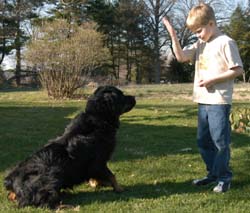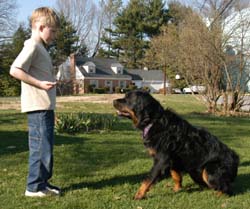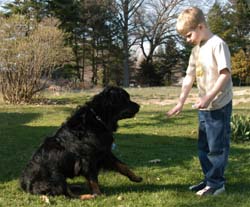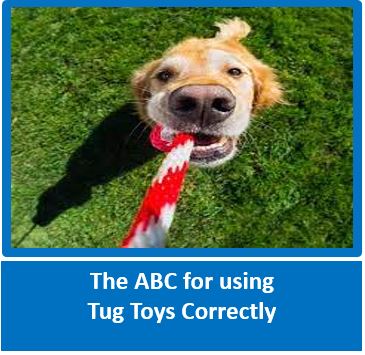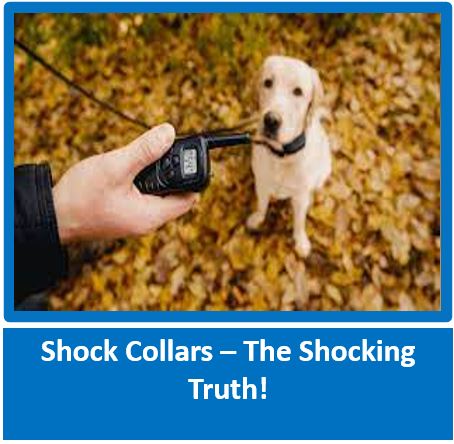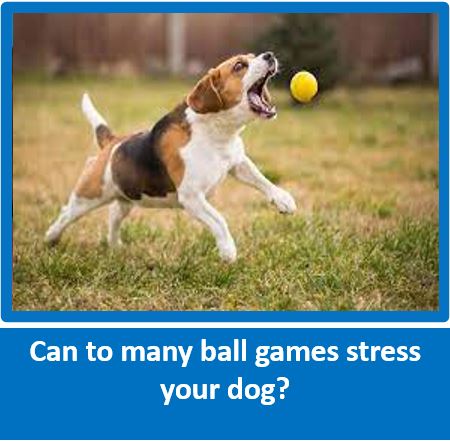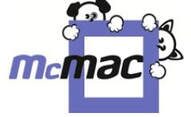
If you want to do Clicker training or teach your dog tricks, we have 2 great options for you to choose from. We also have a huge variety of top name, top quality dog toys to suit even the fussiest pet, as well as toys for cats and your small critters. It does not stop there - we have just about everything else you will need for your pet, including the small critters. www.mcmac.co.za
Clicker Training On-Line Course by Mary Woodward
www.greenwooddogs.com : www.clickerlessons.com
Lesson Four
Sit, Down & Stand
Be sure you have finished The Clicker lesson!
Teaching the sit, down & stand are very easy, but may require patience. Instead of physically putting the dog into position, saying the command & hoping he makes the connection, you will be helping him to discover them. Have a bunch of tiny soft treats ready. You are going to use one as a "lure" to help him to get into the position you want. The lure is only used at the beginning - I will show you how to quickly fade it. (Be careful to follow the instructions carefully for that as you want your dog to always respond to you, whether or not you have a treat!). Stand or kneel in front of your standing dog. Show him a treat in your hand, then move it slowly from his nose up & back a bit over his eyes but slightly out of reach. Most dogs will rather quickly sit so they can better reach it. You might need to be patient & wait for a moment. But when he does, immediately C&T and praise. Please remember that the click has to come at the exact moment his rear hits the ground so he learns that that is what got him the treat! At this point you want to give the treat right away, too. It's okay if your dog gets up after the click - the click actually ends the exercise each time. If he doesn't sit at all - maybe keeps backing up trying to get the treat, then just turn away & ignore him for a few moments. Of course... don't give him the treat! Then try again, from the start.
Notice that I never said when to say "Sit." That's because it is best to wait until the behavior is being performed reliably before adding the verbal cue. That way he doesn't connect the word with the wrong behavior. Also, dogs learn the hand signals much more easily so tend to ignore the verbal commands that go along with them. It's best to teach them separately.
Once your dog is sitting, lure him into a stand by moving a treat from his nose straight out (stay parallel to the ground, if you lift up at all he will try to sit again!). Don't move the treat very far - you want him to just get off of his haunches and then stand still. As soon as he lifts into the standing position, C&T!
To continue practicing sitting & standing until that is easy. Be sure at this point you are reinforcing each correct response with a C&T
Sit, Down & Stand
Be sure you have finished The Clicker lesson!
Teaching the sit, down & stand are very easy, but may require patience. Instead of physically putting the dog into position, saying the command & hoping he makes the connection, you will be helping him to discover them. Have a bunch of tiny soft treats ready. You are going to use one as a "lure" to help him to get into the position you want. The lure is only used at the beginning - I will show you how to quickly fade it. (Be careful to follow the instructions carefully for that as you want your dog to always respond to you, whether or not you have a treat!). Stand or kneel in front of your standing dog. Show him a treat in your hand, then move it slowly from his nose up & back a bit over his eyes but slightly out of reach. Most dogs will rather quickly sit so they can better reach it. You might need to be patient & wait for a moment. But when he does, immediately C&T and praise. Please remember that the click has to come at the exact moment his rear hits the ground so he learns that that is what got him the treat! At this point you want to give the treat right away, too. It's okay if your dog gets up after the click - the click actually ends the exercise each time. If he doesn't sit at all - maybe keeps backing up trying to get the treat, then just turn away & ignore him for a few moments. Of course... don't give him the treat! Then try again, from the start.
Notice that I never said when to say "Sit." That's because it is best to wait until the behavior is being performed reliably before adding the verbal cue. That way he doesn't connect the word with the wrong behavior. Also, dogs learn the hand signals much more easily so tend to ignore the verbal commands that go along with them. It's best to teach them separately.
Once your dog is sitting, lure him into a stand by moving a treat from his nose straight out (stay parallel to the ground, if you lift up at all he will try to sit again!). Don't move the treat very far - you want him to just get off of his haunches and then stand still. As soon as he lifts into the standing position, C&T!
To continue practicing sitting & standing until that is easy. Be sure at this point you are reinforcing each correct response with a C&T
The Down is very similar to the sit. Lure him into a sit & kneel in front of him. Use a treat to lure him into the down position. Start the treat at his nose, then slowly drop it straight down to the floor and out a bit towards his toes so he needs to lie down to get it. Be careful not to go out so far that he needs to walk forward to get it! Some dogs drop right away... but most will need a bit of "shaping." For that, C&T if you see any progress (watch for elbows dropping). Eventually your pup will lie all the way down - then you can C&T and enthusiastically praise.
Most dogs do the down more easily at first from a sit, but for some dogs doing it from a standing position is easier. If you'd like to try that, then drop the treat from his nose to the ground as before, but as your are reaching the ground go backwards (between his legs) a little bit instead of forward. Hopefully, he will drop into the "sphinx" position.
Some dogs, especially little ones, can achieve success at first if you stretch out one of your legs, making a bridge for him to walk under. Lure him into a sit in front of your leg, then show him a treat in your hand coming from under your leg and lure him into crawling under your leg to get it. The EXACT instant he is actually lying down, C&T and praise excitedly. What a good dog! Do that a few times, then try again the original way.
To get him back into a sitting position, lure him up the same way (as when teaching the sit), until he sits up, then C&T.
Once your dog is down, you can then practice "doggy push-ups". You know... sit-down-sit-down, C&T'ing each one. But don't forget to also practice plenty of sits & downs from a standing position.
Troubleshooting - is your dog not interested enough in your treats to work for them? Then get better ones. Read the section on treats on the Basic Info page.
NEXT STEP - LOSING THE LURE
Okay, so your dog is popping up & down like a little jackrabbit for that tasty lure, right! Practice a bit more with the lure like that, then proceed to the next step, which is to "lose the lure." If this is not done properly, you will end up with a dog that will perform the behavior only if he sees a treat. Hardly what we want! Instead, by carefully phasing out the lure, you teach him that it is not the sight of a treat that gets him a reward, but response to your command.
Review a few times luring him up & down with a treat in your right hand, C&T'ing each response. When you lure up for the sit, have your hand palm up. When you lure for the down, have your hand palm down. Next step is to have a treat in your signal hand, as before - that treat will still act as the lure but will NOT be given to your dog. Have a bunch of little treats in your other hand. Lure him into a sit (or down) with your signal hand, click, but then give him a treat from your otherhand. He doesn't get the treat from the signal hand at all! Don't forget to click as soon as he sits (or downs), just before giving the treat.
(a video demonstrating this is coming soon!)
Practice quite a few sits & downs, as well as sits from a stand that way. Very soon he will perform the behavior, then quickly look toward your other hand. That's good! What a clever dog!
Remember... if you know you did plenty of reps of the previous step (at any point in the training of any exercise) and your dog just doesn't respond correctly, then look away for a moment, giving him time to think about it. It's funny when they start offering all sorts of behaviors, hoping for the reward! They lie down, offer a paw, bark... just smile & think about how clever your dog is to try all of those things... and wait for him to get it right! Then click & jackpot!
The next step will to be to go to using your signal hand to just give the signal (the same luring motion but without a lure). First, review a few times with the lure but giving the treat from your other hand as explained in the last step. The last time, go ahead & give him the lure treat, then right away do the exact same motion but with an empty signal hand. As long as your hand motion (the signal) remained the same, your dog will most likely be "faked out" and will respond as before. C&T & praise very enthusiastically! Remember, palm up for sit, palm down for down. Practice this until your dog responds reliably to each signal.
Now, if you are still kneeling or bending down to give the Down signal, it's time to start standing up. You will need to do this in small increments so your dog still understands the signal, getting a bit more upright each time until you are standing upright. Although at first your signal will need to be quite exaggerated you can slowly shape it to be much more subtle. The signal should eventually just be a slight downward motion with your palm down for Down, and a slight upward motion with your palm up for Sit. (Note to obedience competitors - that signal is also accepted in the ring. But if you prefer the arm straight in the air signal, you can just teach that, as well, later!)
Some dogs, especially little ones, can achieve success at first if you stretch out one of your legs, making a bridge for him to walk under. Lure him into a sit in front of your leg, then show him a treat in your hand coming from under your leg and lure him into crawling under your leg to get it. The EXACT instant he is actually lying down, C&T and praise excitedly. What a good dog! Do that a few times, then try again the original way.
To get him back into a sitting position, lure him up the same way (as when teaching the sit), until he sits up, then C&T.
Once your dog is down, you can then practice "doggy push-ups". You know... sit-down-sit-down, C&T'ing each one. But don't forget to also practice plenty of sits & downs from a standing position.
Troubleshooting - is your dog not interested enough in your treats to work for them? Then get better ones. Read the section on treats on the Basic Info page.
NEXT STEP - LOSING THE LURE
Okay, so your dog is popping up & down like a little jackrabbit for that tasty lure, right! Practice a bit more with the lure like that, then proceed to the next step, which is to "lose the lure." If this is not done properly, you will end up with a dog that will perform the behavior only if he sees a treat. Hardly what we want! Instead, by carefully phasing out the lure, you teach him that it is not the sight of a treat that gets him a reward, but response to your command.
Review a few times luring him up & down with a treat in your right hand, C&T'ing each response. When you lure up for the sit, have your hand palm up. When you lure for the down, have your hand palm down. Next step is to have a treat in your signal hand, as before - that treat will still act as the lure but will NOT be given to your dog. Have a bunch of little treats in your other hand. Lure him into a sit (or down) with your signal hand, click, but then give him a treat from your otherhand. He doesn't get the treat from the signal hand at all! Don't forget to click as soon as he sits (or downs), just before giving the treat.
(a video demonstrating this is coming soon!)
Practice quite a few sits & downs, as well as sits from a stand that way. Very soon he will perform the behavior, then quickly look toward your other hand. That's good! What a clever dog!
Remember... if you know you did plenty of reps of the previous step (at any point in the training of any exercise) and your dog just doesn't respond correctly, then look away for a moment, giving him time to think about it. It's funny when they start offering all sorts of behaviors, hoping for the reward! They lie down, offer a paw, bark... just smile & think about how clever your dog is to try all of those things... and wait for him to get it right! Then click & jackpot!
The next step will to be to go to using your signal hand to just give the signal (the same luring motion but without a lure). First, review a few times with the lure but giving the treat from your other hand as explained in the last step. The last time, go ahead & give him the lure treat, then right away do the exact same motion but with an empty signal hand. As long as your hand motion (the signal) remained the same, your dog will most likely be "faked out" and will respond as before. C&T & praise very enthusiastically! Remember, palm up for sit, palm down for down. Practice this until your dog responds reliably to each signal.
Now, if you are still kneeling or bending down to give the Down signal, it's time to start standing up. You will need to do this in small increments so your dog still understands the signal, getting a bit more upright each time until you are standing upright. Although at first your signal will need to be quite exaggerated you can slowly shape it to be much more subtle. The signal should eventually just be a slight downward motion with your palm down for Down, and a slight upward motion with your palm up for Sit. (Note to obedience competitors - that signal is also accepted in the ring. But if you prefer the arm straight in the air signal, you can just teach that, as well, later!)
The next steps are to vary where you are when you give the signals. Work on standing a bit farther away each time as well as standing at different angles (and beside your dog) before giving the signals. Remember to practice each of those more advanced things separately so each will be stronger.
Adding Verbal Signals
Once your dog is responding reliably to your hand signals, you can teach him the verbal signal for each behavior. Since dogs communicate primarily through body lanuage, the hand signals were very easy - the verbal signals take a bit more effort.To make it easier, you are going to connect the new word (Sit, Down, or Up) to the already familiar hand signal for each behavior. To do this, say the word (i.e. "Down") and then immediately after, give the hand signal. Repeat, until your dog responds to the new word before you had a chance to follow through with the hand signal. Be careful to separate the verbal signal from the hand signal - if you say the word at the same time as giving the signal, your dog will focus on the familar hand signal and won't likely notice the word. But if he repeatedly hears the word and learns that the hand signal will follow it, he will connect the behavior you want (in this example lying down), to the word.
Phasing Out the Clicker
So when do you stop using the clicker for these exercises? Whenever you feel that the dog has really learned the signals and is very reliable in responding to them. Does that mean at that point you never need to reinforce the behavior? Certainly not! Make an actual treat reward not as common. Instead, get the response,then praise enthusiastically, praise quietly, throw a ball, play tug 'o war, give his dinner, open the door to go outside - whatever. The best trainers are variable & unpredictable! The dog never knows what he's gonna get or when... that makes it all the more fun for him. If you don't believe me... take a stroll past the slot machines in Las Vegas!
If, after time, you start getting less of a response, just go back to positively reinforcing more often for a short time to refresh his memory. You never 100% stop using treats or rewards. A behavior that is never reinforced will go away. A behvior that is reinforced variably with stay strong. With compulsion (leash checking, etc.) methods, you would always go back to a few quick, sharp checks as reminders or as a warm up before going into the obedience ring. With purely positive methods, you simply "review" positively rather than negatively.
Have fun!!
Adding Verbal Signals
Once your dog is responding reliably to your hand signals, you can teach him the verbal signal for each behavior. Since dogs communicate primarily through body lanuage, the hand signals were very easy - the verbal signals take a bit more effort.To make it easier, you are going to connect the new word (Sit, Down, or Up) to the already familiar hand signal for each behavior. To do this, say the word (i.e. "Down") and then immediately after, give the hand signal. Repeat, until your dog responds to the new word before you had a chance to follow through with the hand signal. Be careful to separate the verbal signal from the hand signal - if you say the word at the same time as giving the signal, your dog will focus on the familar hand signal and won't likely notice the word. But if he repeatedly hears the word and learns that the hand signal will follow it, he will connect the behavior you want (in this example lying down), to the word.
Phasing Out the Clicker
So when do you stop using the clicker for these exercises? Whenever you feel that the dog has really learned the signals and is very reliable in responding to them. Does that mean at that point you never need to reinforce the behavior? Certainly not! Make an actual treat reward not as common. Instead, get the response,then praise enthusiastically, praise quietly, throw a ball, play tug 'o war, give his dinner, open the door to go outside - whatever. The best trainers are variable & unpredictable! The dog never knows what he's gonna get or when... that makes it all the more fun for him. If you don't believe me... take a stroll past the slot machines in Las Vegas!
If, after time, you start getting less of a response, just go back to positively reinforcing more often for a short time to refresh his memory. You never 100% stop using treats or rewards. A behavior that is never reinforced will go away. A behvior that is reinforced variably with stay strong. With compulsion (leash checking, etc.) methods, you would always go back to a few quick, sharp checks as reminders or as a warm up before going into the obedience ring. With purely positive methods, you simply "review" positively rather than negatively.
Have fun!!
|
Introduction
Charging the Clicker Targeting Sit, Down, Stand Sit, Down, Stay Leash Walking Recall Wait Nail Clipping Leave It |

